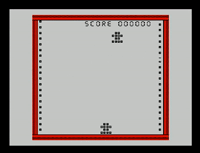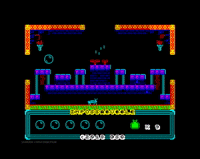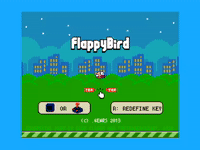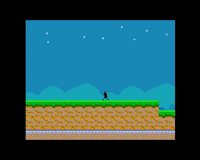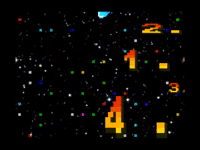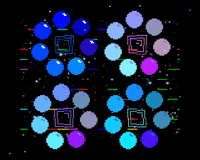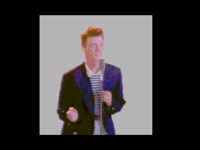CRASH Radio
Latest YouTube Video
My Projects
"The dev log of a man who loves retro gaming and lives by the beach."
-18th December 2023-
Certain keys and doors are now colour-coded for now to make it easier to match them up. Collecting the key in room 5 for the door in the background and then using it to open the door now works, while you are not able to open the door without having first unlocked it.
The only door left to code, and place, is the one that the big key unlocks, which leads from room 4 to room 5 at the top.
All doors are now in and all keys for the doors work with them accordingly.
-17th December 2023-
Work has begun on the door opening and closing in the background in rooms 2 and 5. More work to be done, like the player walking out of the doorway and the door closing behind them, but this has been a lot of work so far and I'm quite pleased with how this part has come along today.
Now coming out of the doorway and the door closing behind. I've also managed to centre the player to the door too when they are near enough to open it. This also means I should be able to duplicate this to centre the player on the chains. I've made it so that you have to be mostly touching the door knob to open the door. When you come out the door the other side you have to move left slightly to be able to open the door again so as not to accidentally go through the doorway again.
-16th December 2023-
A lot of data-reorganisation today to make managing collected items easier and the entities they effect.
The 2nd door now shows up from another room and also doesn't show if you have opened it from the other side (room 5). I have now added a weight pickup to room 5 in preparation for adding the pressure pad to room 4 and the effects this will have on moving platforms and bars.
Most doors and keys are in and in rough positions for now while I test the mechanics. All working ok so far. 1 more door to place, 2 more doors to code. I'll put the bars in next then the pressure pads.
-15th December 2023-
Collected items show up at the top and when using an item it correctly gets removed and the items get reordered.
A 2nd door is in and working. Will add the others and bars before moving on to the weights and pressure pads.
-13th December 2023-
Collected items now show up at the top. I just need to code removing items from the player's inventory then showing that at the top too.
-12th December 2023-
Collecting the appropriate key will now allow you to unlock the relevant door.
-11th December 2023-
New enemy drawing code in. I've created more virtual sprite pattern slots meaning lots more are available now than before. We currently have 4 enemies, each with 8 frames of animation. This meant that 32 of the 64 slots available were being used, but I've now condensed this to just 4 slots being used. Now I can get on with keys and their respective doors, etc.
I've created new sprite sheets containing small keys, doors and bars. This is to make it easier to show/hide the relevant entity. I've also created a sprite sheet for the door that opens in the background. All these are now in the source code.
I have now sorted collision code for all the keys and doors (bars yet to be done). I have placed keys and a door in room 1. I am able to pick up a key and use it with the door. I now need to remove both parts of the door as it is taller than 16 pixels and to prevent the player from moving if the door is present. I will also need to do this for the bars.
-7th November 2023-
I've done moving platforms now. Working with both up and down platforms and left and right.
-6th November 2023-
Some prep work for moving platforms today. A basic sprite and basic movement has been sorted. Collision is already sorted as I've integrated it into my enemy movement code so I just need to sort out fine collision-checking and then move the player with the platform.
-5th November 2023-
I have now been able to centre the player when climbing. That's another thing ticked off.
-4th November 2023-
I've been working on climbing the last couple of days and have been able to prevent the player from moving left or right when on a rope. Next step will be to allow them to jump off the rope while holding a direction.
I can now get the player to jump off a rope when holding left or right and can prevent them from moving left or right while on the rope. Some tweaking is needed to centre the player when climbing the rope, but otherwise I'm happy with it.
-2nd November 2023-
Platform distance jump testing today:
Climbing is mostly working now. Need to refine it and make sure the player can only go up or down when in the exact centre and not let the player move left or right while on the rope. Then I'll code in the player jumping off the rope in the relevant direction.
-1st November 2023-
A bit more work on the ramps today. Some tweaking done when you jump/land on a ramp.
I've now added in an idle animation I received today.
-31st October 2023-
Ramps work going down now too. A bit of tweaking to get it just right, but hard part is done.
-30th October 2023-
I've coded in some ramps today. Need to sort going down a ramp, but it's mostly there.
-28th October 2023-
I now have a process flow for custom palettes. On the left, Simon's graphics. On the right, the same image converted to layer 2 graphics with a custom palette, generated from the image itself.

-26th October 2023-
I've just added the turn animation for going through doors. I can fine tune it when the final graphics are in place, but the core code is there.
I'm pretty much there with all the main code now.
-25th October 2023-
A bit of prep work today. I've added an attribute to my screen editor for doors and have added in a basic check for doors in the assembly code.
-24th October 2023-
Today I've implemented the same code for moving left and right as I have in moving up and down. This means that instead of always checking 2 pixels in front of the player the number of pixels checked is the player speed. This is particularly important for the jump routine as it moves the player more than 2 pixels in 2 of the 4 frames.
-21st October 2023-
I've been tidying up the code a bit today. I have also optimised the screen drawing routine by using several LDI instructions, instead of a , and it's quicker.
-17th October 2023-
The jump has been altered based on an animation I received and I have added some sound effects with a sound bank I was sent this morning.
-16th October 2023-
I've coded in the jump routine to include the jump animation. There's an intentional slight delay before the player jumps. The jump arc needs to be adjusted, but it's otherwise there.
-14th October 2023-
I've refined the fixed jump routine and have amended the jump table in preperation for coding in the jump animation.
-13th October 2023-
I've made some adjustments to the collision box around the player when colliding with walls, platforms, conveyors, etc. The player no longer 'floats' if they are right at the edge of a platform. The player can also go right up to a wall, etc. rather than having a small 2-pixel gap in-between.
I've been sent some player animations today and have converted these to sprite sheets and included them in the source code, ready to be used. The walking animation code was already in, so just 2 more animations to code in.
-10th October 2023-
Today I've coded, and added an option for, a fixed jump, Manic Miner style. It's a simple toggle, set with either a 0 or 1 when the source code is compiled, to easily disable or enable it.
-9th October 2023-
I have now coded a much cleaner screen transition. When the player moves to a new screen, the new screen is drawn in a buffer. When it's finished drawing, the active layer 2 bank is switched to the buffer meaning the new screen is shown much more efficiently and you don't see it being drawn in, it just appears.
I've got the enemy movement and enemy collision detection running within the interrupt routine now. Tests have gone well and it's perfect on real hardware too. This means I'll have plenty of cpu time for the main game and all the various checks.
-8th October 2023-
I've refined the code for platforms and conveyors so that you don't land halfway up them, you can only land directly on them.
I'll look into optimising the screen drawing routine to possibly use the shadow screen to draw the new screen to, then flip to that screen so that it's a smoother transition.
-6th October 2023-
I have now introduced deadly tiles so if you touch them you die. Testing has gone well with this and I'll look into adding more block types.
I've just added in conveyor belts for both left and right and they are working really well. They are treated as a platform so the player can jump up through them and land on them. When they have landed on them they then go the relevant direction of the conveyor at the normal player speed.
-5th October 2023-
I've written a base64 encoder in NextBASIC as an add-on to my editor to deal with CSpect's 7-bit ESP emulation and have been testing this out with the tilemaps and sprite placement. It works very well and means I can continue to use CSpect to create tilemaps/place sprites.
-2nd October 2023-
I've been testing my editor with the sprite placement code and it works very well with the data being uploaded from CSpect. CSpect only supports 7-bit ESP emulation so a bit of work is needed to support values over 127.
-30th September 2023-
In my NextBASIC editor I can now show how many sprites have been placed for the current screen and can also animate them along their movement paths. I can also edit existing sprites, changing any of their properties, and immediatley view the results. I've also added a 'delete sprite' function. All that I need to do now is test the editor more and then test the sprite data output files in my assembly code.
-28th September 2023-
I'm making good progress with my sprite placement add-on for my screen editor. I can place a sprite and then easily select all of its properties. I just need to define how many sprites have been placed for the current screen and then show each sprite's properties.
-26th September 2023-
I'm enhancing my screen editor, written in NextBASIC, today to include a sprite placement section. Will make mapping out screens and setting up enemy movement patterns and limits much easier. It automatically uploads to my server for including in the source file too for ease.
-25th September 2023-
I've been stress testing the engine and have managed to get 20 enemies with individual movement limits, animation speed, etc all moving with collision detection with the player with no issues.
-22nd September 2023-
I've made good progess with my screen editor. I now have a tile select screen and the ability to view just the attributes on their own so you can easily see what you have selected as a solid wall, platform etc. It could do with a few QoL updates, but it's perfectly usable. Next up will be for me to stress test the engine with a large number of enemies on screen, etc.
-21st September 2023-
I've gone back to my screen editor in NextBASIC with the plan of giving it extra functionality when I receive the game graphics. At the moment you can only place one tile pattern, but this needs to be that you can select any tile to be placed. To facilitate this I have written a BASIC program which converts a sprite file for 8x8 tiles. This enables me to draw tiles in the built-in sprite editor normally, instead of in a linear fashion, meaning it is easier to see what they will look like. My converter program then converts the 8x8 tiles to the linear pattern required to place them with the BASIC command, TILE. I am also using the method of reading the tile sheet in a linear fashion in assembly, the same as the TILE command, so this will aid in that too.
-20th September 2023-
I've finished tidying the code up and NextDAW music and AYFX sound effects are fully working now. I've created my own macro too so that instead of writing the assembly each time I want to play a sound effect I just write 'sound x' which is much easier. I'll do this with NextDAW tracks too so I can just write 'music x' and it will setup the relevant track to be played. I may also write macros for 'music stop' and 'music play' to make things a little easier later on.
-19th September 2023-
I have now fully incorporated the AYFX player and NextDAW player, with both working together on interrupts. I have added the ability to select which AY to use for the AYFX player with the plan of having 6-channel NextDAW tracks that use the first 2 AY chips, leaving the 3rd for sound effects. I have tested this with a 6-channel NextDAW track using the first 2 AYs and sound effects being played on the 3rd AY and this works very well. Now, a little bit of work is needed to tidy the code up a bit before I move on to the next task.
-18th September 2023-
Today I've been incorporating Shiru's AYFX player into the code. It works, but I just need to double check the code and then add the ability to select which AY chip the effects play on so they don't interfere with NextDAW.
-16th September 2023-
Memory reorganisation completed. I now have a NextDAW track playing in the game!
-13th September 2023-
I have now incorporated interrupt code and have the code in place for the music player in the main code. Some memory reorganisation is needed before it can be fully implemented as, at present, the NextDAW player requires 4 MMU slots.
-12th September 2023-
I've been able to play a NextDAW track using the NextDAW runtime player today. I've also been exploring interrupts and will look at incorporating the player and interrupts into the main code.
-7th September 2023-
Today I've written a routine for the player colliding with an enemy. I have a basic death routine which just turns the border red and restarts the game. I'll carry out further tests to check performance as currently I'm checking it with 4 enemies on screen. The routine does only 2 checks, one for X and one for Y. After some calculations the carry flag is checked and if it's set for both X and Y then a collision has taken place. It's working well so far.
-5th September 2023-
I'm very happy as I've made good progess with the enemy code. I've created a routine that runs when the player changes a screen to draw the enemies for that screen, based on the screen number and lookup tables I have created. First, I disable sprites, draw the new screen, lookup the enemy data which includes 8k bank and offset, set MMU slot 0 to the 8k bank, copy the data to my enemy buffer, then enable sprites. The next step will be to integrate my player animation code into the enemy movement code.
I've added 2 extra bytes to each enemy's data to hold the animation timer and frame. This also means each enemy can start at it's own unique frame, if required. Enemy buffer size is now 300 bytes, 15 bytes each enemy. I'll need to make some adjustments to the enemy data lookup table to accomodate this.
Another update today and I can now animate enemies. Lots of testing to take place with this to make sure it works as it should then the next step will be to check if the player has collided with an enemy which I should be able to integrate into the enemy movement routine.
-4th September 2023-
I've moved the enemy data to 8k banks and have created a lookup table with the 8k bank and offset for the relevant screen. I'll then perform a lookup when the player moves from one screen to another and pull the enemy data for that screen and copy it to the enemy buffer.
At the moment, the enemy data and screen data will support up to 100 screens with up to 20 enemies per screen. This is with me working in the confines of 1MB RAM so if the game needs to have more data stored I can look to squeeze more into 1MB though I do need to account for data such as music and sound effects. I could expand it meaning support would only be for 2MB machines, but more data could be stored.
-2nd September 2023-
I've just sorted the 9-bit values for the enemy movement so that they display correctly when they're at the edge of the screen. Next step now will be to look at enemy data per screen. Plan is to store the number of enemies per screen in a similar way I store the screen data.
-1st September 2023-
I've managed to steal a few minutes today and am continuing my work on the enemy code. I have allocated a buffer for enemies that are currently on screen which will contain around 13 bytes per enemy. The buffer will be written to each time the player moves from one screen to another. Data per enemy will include, x, x from, x to, y, y from, y to, x direction, y direction, x speed, y speed, pattern from, pattern to and animation speed.
Further tinkering today has meant that I am utilising the index registers for enemy movement. The index registers are loaded with the enemy data for the current screen then each enemies parameters are obtained by a common offset for each meaning I only need add the amount of bytes for each enemy to move to the data for the next one. This has made it easier for me to draw several enemies to the screen, each with their own unique movement limits and speed. Next steps will be to set enemy data according to the screen the player is on.
-27th August 2023-
I'm creating enemy code at the moment and am testing automatic movement for enemies between fixed points and with a fixed speed. It's working well so far. Lots more work to do here such as creating a table holding the enemy data for each screen including how many enemies there are for a particular screen, their starting position and direction, their movement limits, sprite patterns, how many frames of animation they have and their speed. Then will come collision detection with the player.
-26th August 2023-
The player movement speed has been slowed down and I've added an animation timer to slow the speed of the animation down. The jump table has been slightly adjusted so you float a bit more. I've also made a couple of tweaks to the code for moving from one screen to another. Plenty more testing to do with that, but it's getting there.
After some tweaking I am happy with my screen code when moving from one screen to another. Now I just need to create some more screens to test that with. One of the next steps will be to create some enemy movement code.
-24th August 2023-
The sprite data is now in the source file for the main character and I have loaded the first frame of animation successfully. Next steps will be to load the rest of the sprite data into the sprite patterns then create an animation routine.
Player sprite fully loaded in now and is animating when the player presses left or right, correctly cycling through all 8 frames of animation. Next step will be to slow the rate of animation down as it is currently too fast.
-22nd August 2023-
I've created a basic, 2-dimensional, 10x10, game map and can traverse it accordingly. I can specify the starting position on the map too. I will be extensively testing this to ensure there are no errors, for example making sure you can't go off the game map. I'll create a few more basic screens too to aid with this.
-21st August 2023-
I have amended the screen drawing routine to use 1 MMU slot instead of mapping 1 layer 2 16k bank to $0000. The MMU slot is slot 1, meaning the ROM is getting paged out, and I will use slot 2, the other half of the ROM, for tilemap and collision data.
I have just created a screen in my NextBASIC screen editor and been able to include it in a NEX file to be drawn within seconds. Very happy with this as I can draw screens and test them out in a NEX file very quickly.
I've made a small lookup table of around 200 bytes (currently allowing up to 100 screens) which stores the 8k bank a screen's data is stored in and it's offset. This means I have written a routine that enables me to simply specify the screen number, 1,2,3,etc., for it to be drawn. The routine takes the screen number and uses the lookup table to obtain the relevant 8k bank the tilemap and attribute data is in. The tilemap and attribute data are then copied into a common MMU slot used by my main screen drawing routine.
Further tinkering today - I have now integrated my player input code into the main code with the screen drawing routine meaning I can now move the player around after I have called my screen-drawing routine. Next steps will be to create a basic game map using the screen numbers and move the player around it.
-20th August 2023-
Today, I've been able to use my z80 editor to create a binary file that only holds the tiles and tilemap data. I've then been able to include this file when assembling the source code. This means that I can now have external data files which makes the source code a bit easier to manage and will also help me to automate the creation of projects in the future by creating files that contain common setup code, etc.
I've been testing with uploading data directly from CSpect to my server and it works very well. The plan with this is to add this functionality to my screen editor then I can directly upload the screens I design to be included in a NEX file.
After tinkering a bit more today I have integrated the upload code into my screen editor and have been able to save some screen data in CSpect (tilemap and attribute data for collision checking), upload it, and include it in a NEX file. Next steps will be to display it which will require some data reorganisation.
-14th August 2023-
I'm now getting the hang of NEX files and have managed to create a source file that loads data, such as the tiles and tilemap, into a specified bank and then recall that data later on. This means I'm no longer assembling everything to the main memory and can now concentrate on data structures etc although one of the next steps will be to get the main player sprite data into my source file.
-11th August 2023-
I have been experimenting with creating NEX files to aid in displaying a layer 2 tilemap in assembly as it appears that when I try to incorporate the assembly with BASIC for this purpose it causes memory errors. This means I have successfully created my first NEX file! It's just a basic file that displays the standard layer 2 palette, but it works without issue. Next steps will be to integrate my existing layer 2 tilemap code into this to display a full layer 2 tile-mapped screen.
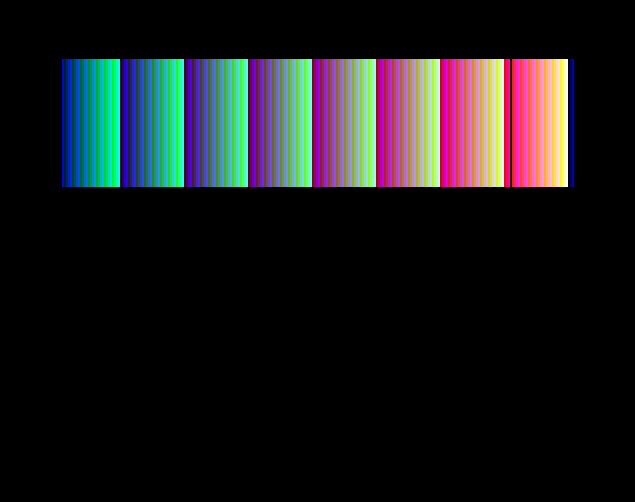
After experimenting a bit more today I'm now able to display a full layer 2 tilemap in assembly. The routine needs a bit of work, but I should be able to integrate my platformer code into it.
-9th August 2023-
I've managed to set part of layer 2 to an MMU slot and read/draw part of a tilemap which I'm very pleased about. This means that I've been able to draw 4 rows of 8x8 tiles at the top of the screen.
So far, this particular routine is about 200 bytes. All I need to do now is make a to run through the routine 6 times (each MMU slot is 8K, 8x6=48K, the size of a standard layer 2 screen).
-7th August 2023-
I've been able to display a full row of tiles from a tile map in assembly so far. More work to be done as each MMU slot holds 8K of data, 4 rows of 8x8 tiles each slot, so will need 6 swaps in total to accommodate the 48K of a standard layer 2 screen, but it's a promising start.
-5th August 2023-
I've managed to load in a tile sheet, in BASIC, and write a routine that displays a particular tile on the screen, in assembly. Now I need to work with that routine to display the tiles according to a tile map.
-4th August 2023-
In preperation for using assembly to draw a screen in from tiles, instead of what I'm currently doing which is using the TILE command in NextBASIC, I have begun looking into using the MMU slots. So far I have been able to page out the ROM, page in a Layer 2 bank, write to it, then page the ROM back in. I'm paging the ROM out and back in again as I am using NextBASIC to facilitate testing my assembly code. Next steps will be to load in the tiles and a basic tilemap, page them in to MMU slots, page a layer 2 bank into an MMU slot and , finally, draw the tiles on screen. Then I can put together a routine which will draw a whole screen, by paging in the necessary banks at the required times.
-3rd August 2023-
Building on yesterday's code, I've created seperate routines to detect when the player is at the edge of a defined screen area. These routines are setup in such a way that all I need to do is add the relevant code for drawing in the new screen depending on which direction the player has exited the current screen.
-2nd August 2023-
Today, I've done some prep work in assembly to set screen limits to stop the player going off screen and also to facilitate moving from one screen to another.
-29th July 2023-
I've been away for a few days and am just getting back into the swing of things. I've gone back to my screen editor and made it a bit more user-friendly. The current plan is to design a few basic screens, create a game map then allow the player to traverse it. I'll do this in BASIC initially, but will convert it to assembly when I'm happy with it. Then I'll look into the possibility of getting the sprite data into assembly and animating it in assembly as I'm currently doing this in BASIC.
-17th July 2023-
I've made a new screen editor in BASIC which allows me to place tiles down on layer 2 as well as attributes on layer 0 (for collision checking) at the same time and I'm able to save and load both. I've tested this with the engine I have in assembly and it works well. It needs some extra features like being able to select the tile you're placing, but it works great for quickly plotting out a screen.
-15th July 2023-
Some work done today in preparation for the game map code. The player sprite can exit the screen one side and appear the other. This also means I can easily add code in for moving from one screen to the next.
-14th July 2023-
The current plan is to get a basic game map sorted and enemies placed on each screen, along with their relevant movement patterns. Initially, I will do this in NextBASIC. This will help me to translate it to assembly.
-13th July 2023-
This is in BASIC at the moment although I will endeavour to convert as much as I can to assembly. The jump arc is not final, but gives you an idea of how it will look.
I have just been testing a seperate assembly module I've made which loads in sprite data directly using the Next registers. It works very well and means this will be another thing I'm able to do in assembly instead of NextBASIC.
-12th July 2023-
I've been sent some artwork and have made a sprite sheet out of it. I have provisionally tested the sprite animation in BASIC and it works very well. I will look into creating a custom palette for it soon. I have been looking into using Next registers to set sprite patterns and will utilise this so that will be one more thing that I should be able to do in assembly as opposed to NextBASIC.
-10th July 2023-
While keeping data storage in mind, I have started work on a screen editor in NextBASIC. This doesn't really need to be in assembly as it is only for designing/mapping out screen data, although this may change in the future. The resulting data will then be added to the assembly code.
At the moment I can place the attributes for solid walls and platforms then easily return to the main to test it out. I also have basic save and load functions which only store one screen at present, but will be expanded so I can make game maps.
-8th July 2023-
I have just got platforms working so you can jump up through them, but can't go down through them. This means there are now 2 main collision checks taking place: solid walls and platforms. It also means that all the main player movement code is done.
Next I will be looking into storing screen data, enemy data (including movement speed, direction etc.), sprite sheets, tiles, etc. All of this I'm doing in NextBASIC at the moment, but I want to get as much as I can into assembly.
-7th July 2023-
I'm very happy as I've just managed to get the jump routine completely working! I can feed any values and it will work just fine. Next up is checking for the player x as a 9 bit value as currently I'm checking it as an 8 bit value (it goes over 255).
And now I can successfully use the player x as a 9 bit value!
Next up is checking for platforms that the player can jump up through, but can't go down through.-6th July 2023-
-5th July 2023-
I've made some QoL changes to my z80 web editor. A bigger code area and better syntax-highlighting.
MUL opcode is now in place instead of ing to get the required attribute for platform-checking meaning the code is more efficent now (and I saved a handful of bytes too).
-3rd July 2023-
I've finished tweaking the fall routine and it works the way I want it to now. I can feed in any values to the fall table and it will work with any of them. Next up is the jump routine. Now that the fall routine is complete it should help me with the jump routine.
The code is just under 700 bytes currently, which includes the data for the jump/fall routines.
-2nd July 2023-
The values from the fall table are now in use so this means there is now gravity. I'm maintaining a fall pointer to say how far into the table the fall is and moving the player down the relevant number of pixels in the table. A few tweaks to make it perfect, but it works very well. Once this is done I will work on the jump table.
-30th June 2023-
The jump and fall tables are now in place in assembly so the data is there. What I need to do now is use that data for the jump and fall routines accordingly.
-29th June 2023-
I now have a basic fall routine in place whereby the player will fall at the current player speed until they land on a platform. All I need to do now is generate a fall table which I can then feed in when the player falls to better simulate gravity like I have already done in BASIC.
I've also gone through all the code and managed to shave about 50 bytes off due to doing the checks for platforms on layer 0 now. This means fewer checks are taking place, but still producing the same result.
-28th June 2023-
I've finished the tweaks and it works the way I want it to now. Now I'm moving on to gravity with the jump/fall routines. Code is around 700 bytes so far so I'm quite pleased with how small it is.
-27th June 2023-
In assembly I can now move in all directions and detect platforms and prevent movement in all directions. A lot of tweaking now to get it perfect, but the base is there. Once that is done I'll move on to gravity.
-26th June 2023-
I can now move up and detect if a platform is in the way and prevent movement. While I'm not necessarily making a top- down engine, this will help when I implement the jump table.
-23rd June 2023-
In assembly I'm now merging the routines for checking for platforms to see if the player can move and then moving the player. At the moment this means the main game will be completely in assembly, which was my aim.
After this is done, I will move on to converting the jump/fall routines I have in BASIC to assembly.
-21st June 2023-
I can detect input in assembly now. Only very basic, but I can build on it so looking promising to get even more of the engine in assembly.
And now I can move sprites with player input. Again, a lot more to do, but it's looking very good..
Player input workiing in all directions with error checking so it doesn't go off screen and I can set the player speed accordingly.
-20th June 2023-
Been optimising my z80 and it runs very well for the platform detection. I have a better workflow now too.
I'll probably be adding player input next.
-17th June 2023-
I've converted the collision detection to use layer 0 instead and it's much better. Left and right collisions already done. Top and bottom to do now.
And now I can detect pixels at the top and bottom of the sprite so that's all sides I can detect. Lots of tweaking now.
-16th June 2023-
The conversion of the collision detection from BASIC to assembly is going well. I can now detect walls to the left and right of the player sprite.
-15th June 2023-
Pixel detection in assembly when moving left is working. Still a long way to go, but that was one of the hard bits.
-12th June 2023-
Plan now is to put all logic for the engine into assembly, which will include detecting solid walls and platforms. Might rewrite it to use layer 0 instead of layer 1 for attribute-checking. Means it will be easier to store the screen data (less data to store too) and then layer 1 (lo res) could be used for graphics too.
